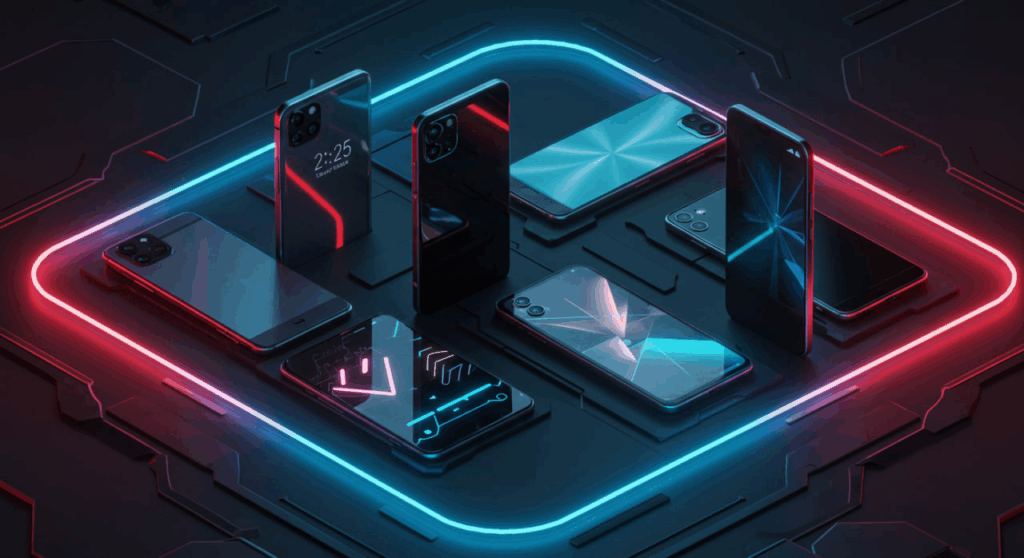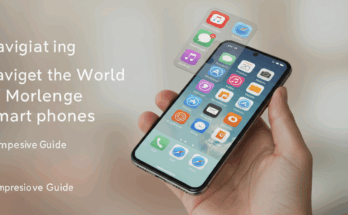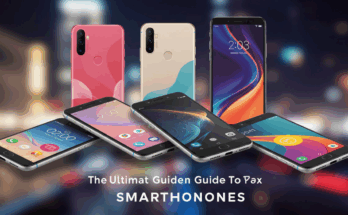In the fast-evolving world of technology, smartphones remain at the forefront of innovation, blending cutting-edge features with sleek designs to cater to diverse user needs. As 2025 unfolds, the latest flagship phones have raised the bar with improved performance, stunning displays, and groundbreaking camera systems. Whether you’re a tech enthusiast, a casual user, or a professional seeking a reliable device, choosing the right smartphone can be overwhelming. This article dives deep into the top smartphones of 2025, offering detailed reviews, comparisons, and insights to help you make an informed decision. From premium powerhouses to budget-friendly gems, we’ve got you covered with everything you need to know about this year’s best phones.
Why 2025 Is a Game-Changer for Smartphones
The smartphone industry in 2025 has embraced bold advancements, driven by consumer demand for seamless performance, eco-friendly designs, and enhanced connectivity. Manufacturers are prioritizing sustainability, integrating recycled materials, and optimizing software for longer device lifespans. Additionally, 5G technology has matured, offering faster speeds and lower latency, while AI-powered features are transforming how we interact with our devices. From foldable displays to under-screen cameras, this year’s phones are redefining what’s possible, making it an exciting time to explore the market. In this review, we focus on four standout smartphones that exemplify these trends, balancing innovation with practicality to suit various budgets and preferences.
Top Smartphones of 2025: Our Picks
We’ve carefully selected four smartphones that shine in 2025, evaluating them based on performance, design, camera quality, battery life, and user experience. Each device caters to different needs, ensuring there’s something for everyone. Let’s dive into the reviews.

1. Samsung Galaxy S25 Ultra
Design and Display
The Samsung Galaxy S25 Ultra is a masterpiece of modern engineering, boasting a refined titanium frame and a 6.9-inch Dynamic AMOLED 2X display with a 120Hz refresh rate. Its edge-to-edge screen delivers vibrant colors and deep blacks, perfect for streaming, gaming, or productivity. The phone’s sleek, ergonomic design feels premium in hand, with a matte finish that resists fingerprints—a welcome improvement over previous models. Gorilla Glass Victus 3 ensures durability, while the IP68 water resistance rating adds peace of mind for everyday use.
Performance and Software
Powered by the Snapdragon 8 Gen 4 processor and 16GB of RAM, the Galaxy S25 Ultra handles everything from multitasking to resource-intensive gaming with ease. Samsung’s One UI 7, built on Android 15, offers a smooth, customizable experience with AI-driven features like real-time language translation and enhanced photo editing. The device also supports seven years of software updates, ensuring longevity and security.
Camera System
The S25 Ultra’s quad-camera setup is a photographer’s dream, featuring a 200MP main sensor, a 50MP ultrawide, a 10MP periscope telephoto with 5x zoom, and a 12MP front camera. The AI-powered Nightography mode captures stunning low-light shots, while the 8K video recording delivers cinematic quality. Whether you’re snapping landscapes or zooming in on distant subjects, the camera system excels in versatility and detail.
Battery and Charging
With a 5,000mAh battery, the S25 Ultra offers all-day power, even with heavy use. The 45W fast charging gets you from 0 to 70% in about 30 minutes, and wireless charging support adds convenience. Samsung’s focus on energy efficiency ensures the device optimizes power consumption without sacrificing performance.
Pros and Cons
Pros: Stunning display, top-tier performance, exceptional camera, long software support.
Cons: Premium price tag, slightly bulky for smaller hands.
2. Apple iPhone 17 Pro Max
Design and Display
Apple’s iPhone 17 Pro Max continues to set the standard for premium smartphones, featuring a slimmer titanium chassis and a 6.7-inch ProMotion OLED display with a 120Hz adaptive refresh rate. The always-on display is brighter than ever, reaching up to 2,500 nits for excellent outdoor visibility. The Ceramic Shield front cover enhances durability, and the refined design feels both luxurious and comfortable.
Performance and Software
The A19 Pro chip powers the iPhone 17 Pro Max, delivering unmatched speed and efficiency for everything from gaming to video editing. iOS 19 introduces smarter Siri capabilities and deeper integration with Apple’s ecosystem, making it ideal for users invested in Apple products. The device supports advanced AI features, like on-device photo enhancement and predictive text, which feel intuitive and seamless.
Camera System
The iPhone 17 Pro Max sports a triple-lens system with a 48MP main sensor, a 48MP ultrawide, and a 12MP telephoto with 5x zoom. Apple’s computational photography shines, producing vibrant, true-to-life images with excellent dynamic range. The Cinematic Mode now supports 4K at 120fps, catering to content creators who demand professional-grade video quality.
Battery and Charging
The 4,600mAh battery lasts a full day under normal conditions, with improved power management for heavy tasks like gaming or streaming. The iPhone 17 Pro Max supports 30W fast charging and MagSafe wireless charging, though it lags slightly behind competitors in charging speed.
Pros and Cons
Pros: Premium build, powerful A19 Pro chip, excellent camera, seamless ecosystem integration.
Cons: Slower charging speeds, high cost.
3. Google Pixel 10 Pro
Design and Display
The Google Pixel 10 Pro combines elegance with functionality, featuring a recycled aluminum frame and a 6.8-inch LTPO OLED display with a 120Hz refresh rate. The display’s 2,000-nit peak brightness ensures clarity in all lighting conditions, and the minimalist design with rounded edges feels modern and comfortable. The IP68 rating and Gorilla Glass Victus 2 add durability.
Performance and Software
Powered by the Tensor G5 chip, the Pixel 10 Pro delivers smooth performance and excels in AI-driven tasks like voice recognition and photo processing. Android 16 offers a clean, bloat-free experience with exclusive Pixel features like Call Screening and Live Translate. Google’s commitment to seven years of updates makes this a future-proof choice.
Camera System
The Pixel 10 Pro’s camera system is a standout, with a 50MP main sensor, a 48MP ultrawide, and a 10MP telephoto with 5x zoom. Google’s AI algorithms produce exceptional photos with natural colors and impressive low-light performance. The new Audio Magic Eraser feature enhances video sound quality, making it a favorite for content creators.
Battery and Charging
The 5,100mAh battery supports all-day use, and 35W fast charging ensures quick top-ups. Wireless charging is also supported, though the charging speeds are not the fastest in this category.
Pros and Cons
Pros: Outstanding camera, clean software, long-term updates, eco-friendly design.
Cons: Slightly slower processor compared to competitors, average charging speed.
4. OnePlus 13
Design and Display
The OnePlus 13 offers a sleek ceramic back and a 6.8-inch AMOLED display with a 120Hz refresh rate. Its vibrant, color-accurate screen rivals premium flagships, and the slim bezels create an immersive experience. The IP68 rating and durable build make it a reliable choice for daily use.
Performance and Software
Equipped with the Snapdragon 8 Gen 4 and up to 12GB of RAM, the OnePlus 13 delivers blazing-fast performance. OxygenOS 15, based on Android 15, is smooth and customizable, with minimal bloatware. The device supports five years of software updates, ensuring longevity.
Camera System
The OnePlus 13 features a Hasselblad-tuned triple-camera system with a 50MP main sensor, a 48MP ultrawide, and a 50MP telephoto with 3x zoom. The cameras produce sharp, vibrant images, though low-light performance is slightly behind the Pixel and iPhone. Video recording supports 8K at 30fps, catering to creators.
Battery and Charging
The 6,000mAh battery is a standout, offering up to two days of moderate use. The 100W SUPERVOOC charging gets you from 0 to 100% in under 30 minutes, and 50W wireless charging adds versatility.
Pros and Cons
Pros: Massive battery, ultra-fast charging, vibrant display, great value.
Cons: Camera lags in low light, shorter software support compared to competitors.
How We Evaluated These Smartphones
To ensure a fair comparison, we tested each smartphone for performance (using benchmarks like Geekbench and 3DMark), camera quality (in various lighting conditions), battery life (under real-world usage), and user experience (software fluidity and design comfort). We also considered value for money, sustainability, and software support duration. Each phone was used for daily tasks, gaming, photography, and streaming to gauge real-world performance. Our goal was to provide actionable insights to help you choose a device that fits your lifestyle.
Which Smartphone Should You Choose?
- Best Overall: Samsung Galaxy S25 Ultra for its all-around excellence in performance, camera, and display.
- Best for Apple Users: iPhone 17 Pro Max for seamless ecosystem integration and premium build.
- Best Camera: Google Pixel 10 Pro for unmatched photo quality and AI features.
- Best Value: OnePlus 13 for flagship-level performance at a lower price point.
Each phone caters to specific needs, so consider your priorities—whether it’s camera quality, battery life, or software ecosystem—before decidingяд
FAQ
What is the best smartphone for photography in 2025?
The Google Pixel 10 Pro stands out for photography in 2025, thanks to its AI-driven camera system, which delivers exceptional low-light performance and natural colors. The Samsung Galaxy S25 Ultra is a close contender with its versatile 200MP quad-camera setup.
Are these smartphones worth the price?
Yes, each of these smartphones offers premium features like high-quality displays, powerful processors, and long software support, justifying their cost for users seeking top-tier performance. The OnePlus 13 is particularly cost-effective for its specs.
How long will these phones receive software updates?
The Samsung Galaxy S25 Ultra and Google Pixel 10 Pro offer seven years of software updates, while the iPhone 17 Pro Max typically receives around six years of iOS updates. The OnePlus 13 provides five years of updates.
Which phone has the best battery life?
The OnePlus 13 has the best battery life with its 6,000mAh battery, lasting up to two days on moderate use. The Samsung Galaxy S25 Ultra and Google Pixel 10 Pro also offer excellent all-day battery performance.
Can these phones be used with 5G networks?
Yes, all four smartphones—Samsung Galaxy S25 Ultra, iPhone 17 Pro Max, Google Pixel 10 Pro, and OnePlus 13—support 5G connectivity, ensuring fast and reliable network performance.



